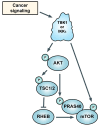Roles for the IKK-Related Kinases TBK1 and IKKε in Cancer
- PMID: 30223576
- PMCID: PMC6162516
- DOI: 10.3390/cells7090139
Roles for the IKK-Related Kinases TBK1 and IKKε in Cancer
Abstract
While primarily studied for their roles in innate immune response, the IκB kinase (IKK)-related kinases TANK-binding kinase 1 (TBK1) and IKKε also promote the oncogenic phenotype in a variety of cancers. Additionally, several substrates of these kinases control proliferation, autophagy, cell survival, and cancer immune responses. Here we review the involvement of TBK1 and IKKε in controlling different cancers and in regulating responses to cancer immunotherapy.
Keywords: IKKε; KRAS; TBK1; autophagy; cancer signaling; innate immunity.
Conflict of interest statement
The authors declare no conflict of interest.
Figures



Similar articles
-
Identification of TBK1 and IKKε, the non-canonical IκB kinases, as crucial pro-survival factors in HTLV-1-transformed T lymphocytes.Leuk Res. 2016 Jul;46:37-44. doi: 10.1016/j.leukres.2016.04.012. Epub 2016 Apr 16. Leuk Res. 2016. PMID: 27123832 Free PMC article.
-
Activation of TBK1 and IKKvarepsilon kinases by vesicular stomatitis virus infection and the role of viral ribonucleoprotein in the development of interferon antiviral immunity.J Virol. 2004 Oct;78(19):10636-49. doi: 10.1128/JVI.78.19.10636-10649.2004. J Virol. 2004. PMID: 15367631 Free PMC article.
-
Involvement of TBK1 and IKKepsilon in lipopolysaccharide-induced activation of the interferon response in primary human macrophages.Eur J Immunol. 2007 Feb;37(2):528-39. doi: 10.1002/eji.200636090. Eur J Immunol. 2007. PMID: 17236232
-
Regulation and function of IKK and IKK-related kinases.Sci STKE. 2006 Oct 17;2006(357):re13. doi: 10.1126/stke.3572006re13. Sci STKE. 2006. PMID: 17047224 Review.
-
Essential Roles for the Non-Canonical IκB Kinases in Linking Inflammation to Cancer, Obesity, and Diabetes.Cells. 2019 Feb 19;8(2):178. doi: 10.3390/cells8020178. Cells. 2019. PMID: 30791439 Free PMC article. Review.
Cited by
-
TBK1-mTOR Signaling Attenuates Obesity-Linked Hyperglycemia and Insulin Resistance.Diabetes. 2022 Nov 1;71(11):2297-2312. doi: 10.2337/db22-0256. Diabetes. 2022. PMID: 35983955 Free PMC article.
-
A Nanoparticle-Conjugated Anti-TBK1 siRNA Induces Autophagy-Related Apoptosis and Enhances cGAS-STING Pathway in GBM Cells.Evid Based Complement Alternat Med. 2021 Dec 11;2021:6521953. doi: 10.1155/2021/6521953. eCollection 2021. Evid Based Complement Alternat Med. 2021. Retraction in: Evid Based Complement Alternat Med. 2023 Jun 21;2023:9870520. doi: 10.1155/2023/9870520. PMID: 34931127 Free PMC article. Retracted.
-
TBK1 regulates regeneration of pancreatic β-cells.Sci Rep. 2020 Nov 9;10(1):19374. doi: 10.1038/s41598-020-76600-6. Sci Rep. 2020. PMID: 33168920 Free PMC article.
-
Regulation of antiviral innate immune signaling and viral evasion following viral genome sensing.Exp Mol Med. 2021 Nov;53(11):1647-1668. doi: 10.1038/s12276-021-00691-y. Epub 2021 Nov 16. Exp Mol Med. 2021. PMID: 34782737 Free PMC article. Review.
-
TBK1 inhibitor amlexanox exerts anti-cancer effects against endometrial cancer by regulating AKT/NF-κB signaling.Int J Biol Sci. 2025 Jan 1;21(1):143-159. doi: 10.7150/ijbs.100212. eCollection 2025. Int J Biol Sci. 2025. PMID: 39744441 Free PMC article.
References
Publication types
Grants and funding
LinkOut - more resources
Full Text Sources
Other Literature Sources
Miscellaneous

